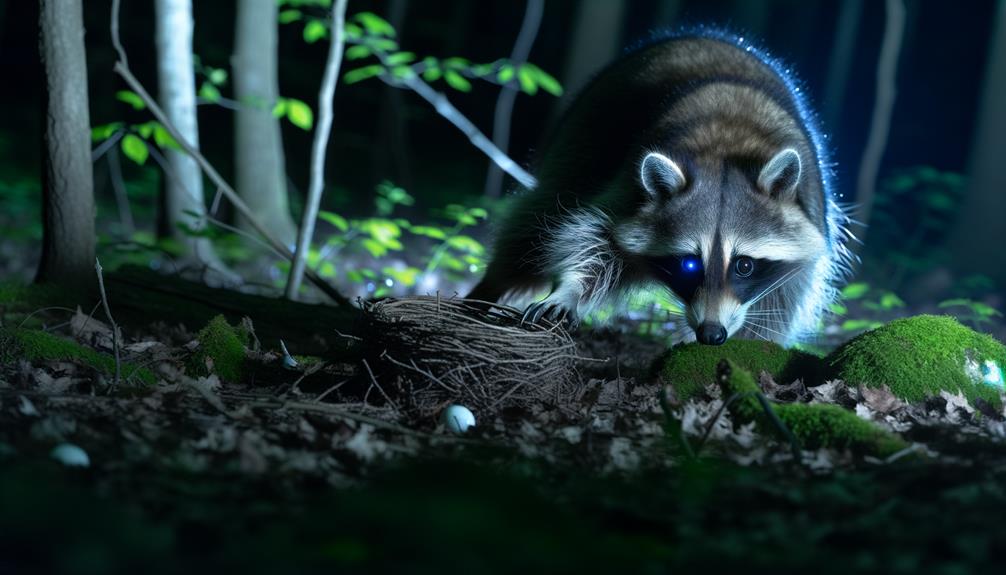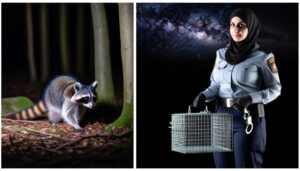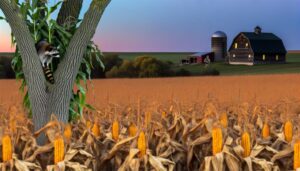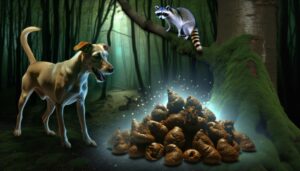How Do Raccoons Kill Their Prey?
Raccoons employ several effective methods for killing prey. They are nocturnal hunters with acute senses, allowing them to locate food efficiently in the dark.
Their highly dexterous paws are used to capture and manipulate prey. Once caught, raccoons use their sharp teeth and powerful jaws to subdue and consume their target.
They often rely on ambush and surprise attacks, and their climbing and swimming capabilities enable them to access a wide variety of prey in diverse environments. These adaptive strategies not only aid in killing prey but also contribute to their thriving in various habitats.
Explore further to understand their versatile diet and survival tactics.

Key Takeaways
- Raccoons use their sharp teeth and strong jaws to efficiently subdue and kill their prey.
- They employ ambush and surprise attacks to catch their prey off guard.
- Their dexterous paws allow them to skillfully capture and manipulate their prey.
- Acute night vision and heightened senses help them locate and hunt prey in the dark.
- Raccoons' climbing and swimming abilities enable them to access prey in diverse environments.
Nocturnal Hunting Tactics
Raccoons employ a variety of sophisticated nocturnal hunting tactics that leverage their heightened senses and adaptability to efficiently locate and capture prey under the cover of darkness. Their acute night vision allows them to detect even the slightest movements in low-light conditions, while their sensitive hearing pinpoints the faintest sounds of potential prey.
Additionally, raccoons possess an exceptional sense of smell, which they use to track down food sources. Their cognitive adaptability enables them to exploit diverse environments, from urban areas to dense forests, optimizing their hunting strategies accordingly.
Utilizing Their Dexterous Paws
In addition to their sensory prowess, raccoons exhibit remarkable dexterity with their paws, which play a pivotal role in capturing and handling prey. These highly adaptable limbs, equipped with five nimble digits, allow raccoons to manipulate objects with precision. Their paws function almost like human hands, enabling them to grasp, twist, and pry open various surfaces and containers.
This dexterity is particularly advantageous when foraging for small animals or insects hidden under rocks, within crevices, or inside other concealed areas. The tactile sensitivity of their paws aids in identifying and securing prey items, often before they become visible. By leveraging their manual skills, raccoons can efficiently exploit a wide range of food sources in their diverse habitats.
Sharp Teeth and Strong Jaws
Possessing powerful jaws and a set of sharp teeth, raccoons are well-equipped to efficiently subdue and consume their prey.
The dental structure of raccoons features incisors, canines, premolars, and molars, all serving specific functions in the predation process.
The sharp canines are particularly effective for piercing and gripping prey, while the molars are adept at crushing and grinding.
Their strong jaw muscles provide the necessary force to break through the exoskeletons of insects or the bones of small vertebrates.
This combination of dental and muscular adaptations allows raccoons to process a wide variety of prey, from small mammals to amphibians, ensuring they can exploit diverse food sources within their habitat.
Ambush and Surprise Attacks
Raccoons employ sophisticated tactics of ambush and surprise attacks to subdue their prey.
Utilizing stealthy approach techniques, they minimize noise and remain hidden until the best moment.
Quick strike methods and the strategic use of their environment further enhance their ability to capture and kill prey efficiently.
Stealthy Approach Techniques
Employing a combination of sharp senses and calculated movements, raccoons execute ambush and surprise attacks with remarkable efficiency. Utilizing their highly developed hearing and sense of smell, raccoons can detect potential prey from considerable distances. Their night vision further aids in maneuvering in dimly lit environments, allowing for stealthy approaches. Raccoons often capitalize on their surroundings, using natural cover to remain unnoticed until the right moment to strike.
- Auditory Acuity: Raccoons possess acute hearing, enabling them to locate prey through faint sounds.
- Nocturnal Vision: Adapted for nighttime activities, their vision aids in quietly stalking prey in the dark.
- Environmental Utilization: They skillfully use terrain and vegetation to hide themselves before launching an attack.
These techniques collectively make raccoons skilled hunters.
Quick Strike Methods
Leveraging their stealthy approach, raccoons execute quick strike methods by launching precise and rapid attacks to incapacitate their prey almost instantaneously. These methods often involve ambush and surprise tactics, where the raccoon utilizes its acute auditory and visual senses to detect unsuspecting prey.
Once the target is within range, the raccoon employs its sharp claws and powerful jaws to deliver a swift and decisive blow. The element of surprise minimizes the prey's chance of escape, ensuring an efficient kill. This predatory behavior is facilitated by the raccoon's agile physique and refined motor skills, which allow it to navigate through various terrains silently and swiftly.
Such quick strike methods are integral to the raccoon's hunting strategy, optimizing energy expenditure and success rates.
Utilization of Environment
In addition to their quick strike methods, raccoons adeptly utilize their environment to enhance ambush and surprise attacks, capitalizing on natural concealment and terrain features to gain an advantage over their prey. Their ability to blend into surroundings and their keen awareness of environmental features play an essential role in their hunting efficiency.
Raccoons make strategic use of:
- Thick vegetation: Providing cover for stealthy approaches.
- Water sources: Exploiting prey's need to drink, where raccoons often lurk.
- Urban structures: Utilizing debris and buildings for concealment in human-dominated landscapes.
These tactics allow raccoons to remain undetected until the best moment to strike, increasing their predatory success. Their environmental adaptability underscores their role as versatile and opportunistic hunters.
Climbing and Swimming Abilities
Raccoons exhibit exceptional climbing techniques, enabling them to access prey located in trees or other elevated areas. Their adept water navigation skills allow them to pursue and capture aquatic prey effectively.
Additionally, these abilities are integral to their predator evasion strategies, enhancing their survival and hunting efficiency in diverse environments.
Agile Climbing Techniques
Possessing remarkable agility and adaptability, raccoons demonstrate exceptional climbing and swimming abilities that aid in their predatory and survival strategies. Their climbing techniques are particularly remarkable, as they can easily scale trees, buildings, and other vertical structures. This ability is facilitated by several anatomical and behavioral adaptations:
- Dexterous forepaws: Raccoons have highly flexible and sensitive forepaws, allowing them to grasp and manipulate surfaces effectively.
- Strong limbs and claws: Their powerful limbs and sharp claws provide the necessary grip and strength to ascend vertical surfaces quickly.
- Impressive balance and coordination: Raccoons exhibit excellent balance, enabling them to navigate narrow branches and ledges with ease.
These climbing capabilities enable raccoons to access nesting sites, evade predators, and hunt efficiently.
Water Navigation Skills
With an innate proficiency in both climbing and swimming, raccoons exhibit remarkable water navigation skills that enhance their predatory efficiency and survival chances.
Their semi-aquatic nature allows them to exploit diverse habitats, ranging from forested areas to urban environments with water bodies.
Raccoons possess strong limbs and dexterous paws, enabling them to climb trees to evade predators or search for food. Additionally, they are adept swimmers, capable of crossing streams, rivers, and lakes to access new feeding grounds.
This dual capability is critical for foraging, as it allows raccoons to hunt aquatic prey such as fish, amphibians, and crustaceans. These skills not only extend their food sources but also provide a strategic advantage in capturing prey across varied terrain.
Predator Evasion Strategies
The same climbing and swimming abilities that facilitate raccoons' foraging also play a pivotal role in their predator evasion strategies. These skills are essential for maneuvering diverse environments and evading threats.
Climbing allows raccoons to quickly ascend trees and structures, effectively escaping ground-based predators. Their agile limbs and sharp claws provide stability and speed during vertical escapes. Additionally, raccoons are proficient swimmers, enabling them to traverse water bodies that may serve as barriers to less adaptable predators. This versatility greatly enhances their chances of survival in the wild.
Key attributes include:
- Climbing: Quick ascension of trees and structures.
- Agile Limbs: Enhanced stability and speed.
- Swimming: Effective traversal of water bodies.
These evasion strategies underscore the raccoon's adaptability and survival prowess.
Foraging and Opportunistic Feeding
Raccoons exhibit remarkable adaptability in their foraging behavior, capitalizing on a diverse range of food sources available within their habitats. Their diet is eclectic and includes plants, insects, small vertebrates, and human refuse. This omnivorous diet allows raccoons to thrive in both urban and rural environments. Their highly dexterous front paws enable them to manipulate objects and access food sources that might otherwise be unreachable. They are known to raid garbage bins, forage in gardens, and even hunt small animals when necessary. Additionally, raccoons employ their acute sense of touch and night vision to locate food in various conditions, demonstrating their opportunistic feeding nature.
| Food Source | Examples |
|---|---|
| Plants | Fruits, nuts, berries |
| Small Vertebrates | Fish, amphibians, rodents |
| Human Refuse | Leftovers, garbage |
Seasonal Variations in Diet
Throughout the year, raccoons exhibit significant changes in their dietary patterns in response to seasonal availability of food sources. During the spring and summer months, they primarily consume a variety of fruits, berries, and insects, which are abundant during this period.
As autumn approaches, raccoons shift their focus to nuts and seeds, preparing for the scarcity of winter. Winter diets are characterized by a dependence on stored food and scavenging, as natural resources become limited.
These dietary adaptations are vital for their survival and reproductive success.
This seasonal adaptability highlights the raccoon's opportunistic feeding strategies and resilience in diverse environments.
Interaction With Other Predators
In addition to their adaptive dietary behaviors, raccoons must navigate complex interactions with other predators within their habitats. These interactions can influence hunting strategies and territorial behaviors. Common predators of raccoons include coyotes, bobcats, and large birds of prey.
Competition for food resources may lead to direct confrontations or avoidance strategies. Raccoons employ nocturnal activity to reduce overlap with diurnal predators and utilize their agility and climbing skills to evade threats. In some cases, raccoons may scavenge kills from larger predators, thereby reducing the need for direct hunting.
Understanding these interactions provides insight into the ecological niche raccoons occupy and their adaptive mechanisms for survival in diverse environments. This interplay underscores the dynamic balance within ecosystems.
Conclusion
To wrap up, raccoons utilize a multifaceted strategy for hunting. They employ nocturnal hunting techniques, nimble paws, sharp teeth, and powerful jaws. Their capacity to surprise, scale, and navigate water enhances their hunting effectiveness.
Additionally, their search for food and flexible feeding methods adjust to seasonal changes in diet. Interactions with other hunters contribute intricacy to their ecological function.
Grasping these behaviors necessitates a thorough study of their varied approaches, showcasing the complexity of this species' survival tactics throughout different environments and eras.






